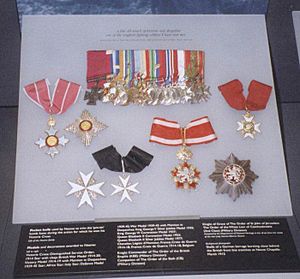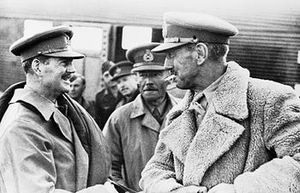Philip Neame facts for kids
Quick facts for kids
Sir Philip Neame
|
|
|---|---|

Philip Neame VC, pictured here as a young officer sometime before, during or after the First World War.
|
|
| Born | 12 December 1888 Faversham, Kent, England |
| Died | 28 April 1978 (aged 89) Selling, Kent, England |
| Allegiance | United Kingdom |
| Service/ |
British Army |
| Years of service | 1908–1947 |
| Rank | Lieutenant General |
| Service number | 4243 |
| Unit | Royal Engineers |
| Commands held | British Forces in Palestine and Trans-Jordan 4th Indian Infantry Division Royal Military Academy, Woolwich |
| Battles/wars | First World War Second World War |
| Awards | Victoria Cross Knight Commander of the Order of the British Empire Companion of the Order of the Bath Distinguished Service Order Knight of the Order of St John Mentioned in Despatches (6) Légion d'honneur (France) Croix de guerre (France) Croix de guerre (Belgium) Order of the White Lion (Czechoslovakia) |
| Other work | Olympic gold medalist Lieutenant Governor of Guernsey |
Lieutenant General Sir Philip Neame (12 December 1888 – 28 April 1978) was a high-ranking officer in the British Army. He received the Victoria Cross, which is the highest award for bravery in battle for British and Commonwealth soldiers.
What makes Sir Philip Neame truly special is that he also won an Olympic Games gold medal. He is the only person ever to achieve both these amazing honors!
During the Second World War, in 1941, he was in charge of British troops in Cyrenaica, a region in north-eastern Libya. This area had just been taken from the Italians. However, when German forces, led by General Erwin Rommel, attacked and took the region back, Neame was captured. He remained a prisoner in Italy until late 1943.
Contents
Early Life and Military Start
Philip Neame was born on 12 December 1888 in Faversham, Kent, England. His parents were Kathleen and Frederick Neame.
He went to school at Cheltenham College. After that, he attended the British Army's Royal Military Academy in Woolwich. This is where future army officers are trained.
In July 1908, after finishing his training, Neame became an officer in the Royal Engineers. This part of the army builds and maintains things like bridges and fortifications. He was promoted to lieutenant in August 1910.
First World War Heroics
When the First World War began in August 1914, Neame was stationed in Gibraltar. His unit, the 15th Field Company, soon joined the British Expeditionary Force (BEF) on the Western Front in France.
During the First Battle of Ypres in October 1914, Neame saw that British hand-grenades were not as good as the German ones. He decided to create a better option. His engineers made simple but effective grenades from empty jam tins. They filled them with scrap metal and gun-cotton, adding a fuse that needed to be lit.
Winning the Victoria Cross
Philip Neame was 26 years old when he earned the Victoria Cross. This happened on 19 December 1914, near Neuve Chapelle, France.
He was leading his team when he was asked to help strengthen a captured German trench. The Germans were counter-attacking with bombs, and the British soldiers had no working grenades. Neame bravely went to the front line. He found that the British grenades couldn't be lit because there were no special matches.
Knowing how to light the grenades without the special matches, Neame began throwing them at the attacking Germans. He did this for 45 minutes, under heavy enemy fire. His actions held back the German attack. This allowed his fellow soldiers to move their wounded comrades to safety.
After this heroic act, Neame was promoted to captain in 1915. He was also mentioned in official reports for his bravery multiple times. In January 1916, he received the Distinguished Service Order (DSO) for his excellent leadership.
He continued to serve as a staff officer, helping to plan military operations. He was involved in major battles like the Battle of the Somme in 1916. By the end of the war in November 1918, he held the temporary rank of lieutenant colonel.
Between Wars: Soldier and Olympian
After the First World War, Neame received more awards from France and Belgium for his service. These included the Legion d'honneur and the Croix de guerre.
| Medal record | ||
|---|---|---|
| Men's shooting | ||
| Representing |
||
| Olympic Games | ||
| Gold | 1924 Paris | Team running deer, double shots |
In 1924, Neame joined Great Britain's Olympic team for the Paris Games. He competed in the "Running Deer" shooting event. This event involved teams of four shooting at a moving target that looked like a deer. His team won the gold medal! This made him the only person to ever win both a Victoria Cross and an Olympic gold medal.
After the Olympics, he continued his military career. He taught at the Staff College, Camberley and served in India. In 1933, while hunting in India, he was badly injured by a tigress. He recovered in a hospital where he met Harriet Alberta Drew, a nurse. They later married.
In 1938, he returned to England as the leader of the Royal Military Academy, Woolwich. He was promoted to major-general.
Second World War Challenges
When the Second World War began, Neame was expected to take a very important role in the British Army. However, he was instead sent to Egypt in February 1940. There, he commanded the 4th Indian Infantry Division.
Middle East Command
In August 1940, Neame was put in charge of British Forces in Palestine and Trans-Jordan. His main job was to keep peace and order in the region.
Defeat in North Africa
In February 1941, Neame became the commander of British forces in Cyrenaica, a part of Libya. This area had recently been captured from the Italians. However, many of his experienced troops were sent to other places, like Greece. He was left with newer, less prepared units and little air support.
His main forces were the 2nd Armoured Division and the 9th Australian Division. The 2nd Armoured Division was new to the desert and lacked proper training and equipment. The 9th Australian Division was also still training and short on vehicles.
First Axis Attack in North Africa
In March 1941, German forces, known as the Afrika Korps, arrived in North Africa. They were led by General Erwin Rommel. Rommel launched a surprise attack. Neame's headquarters did not have good information and didn't know how big the attack would be.
The German and Italian armies advanced very quickly. Neame's forces were spread out and unprepared. His command center was far from the fighting, making it hard to control his troops. As the 2nd Armoured Division struggled, Neame ordered his forces to retreat to avoid being completely destroyed.
On 6 April 1941, Neame and General Richard O'Connor were driving to a new headquarters. They were suddenly surrounded and captured by a German advanced unit.
However, not all was lost. The 9th Australian Division quickly retreated to the coastal town of Tobruk. There, they set up strong defenses. They managed to hold out against the Axis forces in a long siege.
Prisoner of War in Italy
Neame, along with other captured British soldiers, was sent to Italy. He was held in several prisoner-of-war camps, including Castello di Vincigliata. While there, he and other generals, including Adrian Carton de Wiart (another VC recipient), tried to escape many times.
In April 1943, six men successfully escaped through a tunnel that Neame had helped design. After Italy signed an armistice (peace agreement) in September 1943, Neame was released from his prison camp.
He then faced a dangerous journey. He had to travel hundreds of miles through areas still controlled by German forces. With the help of friendly Italians, Neame and his group, including General O'Connor, made their way south. They eventually reached the port of Termoli, which was now held by the Allied armies, on 20 December 1943.
Return to England
Neame arrived back in England on Christmas Day, 1943. Even though he had been a prisoner of war, he remained an active officer until the war ended.
After the War and Retirement

In August 1945, Neame was appointed Lieutenant Governor of Guernsey. This meant he was the Queen's representative on the island of Guernsey. He served in this role until 1953. He also held honorary positions in the Royal Engineers.
He was knighted in June 1946, becoming Sir Philip Neame. He also became a knight of the charitable Order of St John.
Personal Life
Philip Neame married Harriet Drew in 1934. They had four children: Gerald, Veronica, and twins Nigel and Philip. His youngest son, also named Philip, later served in the Falklands War in 1982.
Sir Philip Neame passed away in Selling, Kent, on 28 April 1978, at the age of 89. He was buried in the churchyard of St Mary the Virgin Church in Selling.
His medals and awards are now displayed at the Imperial War Museum in London.


